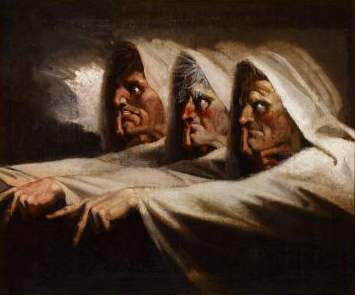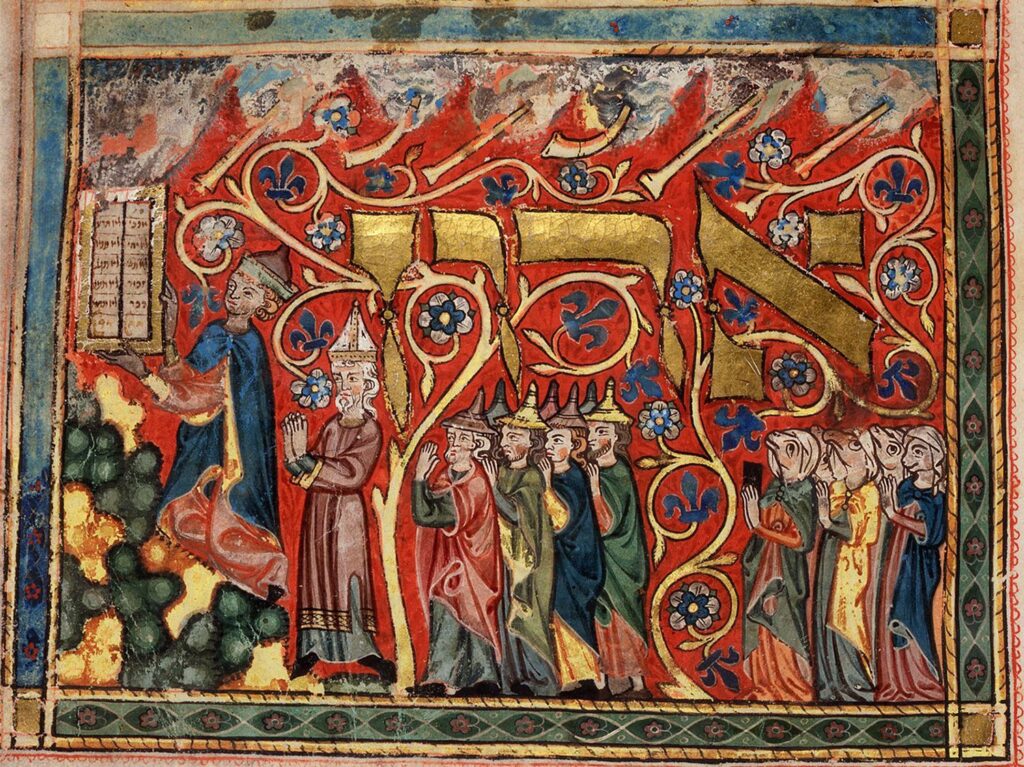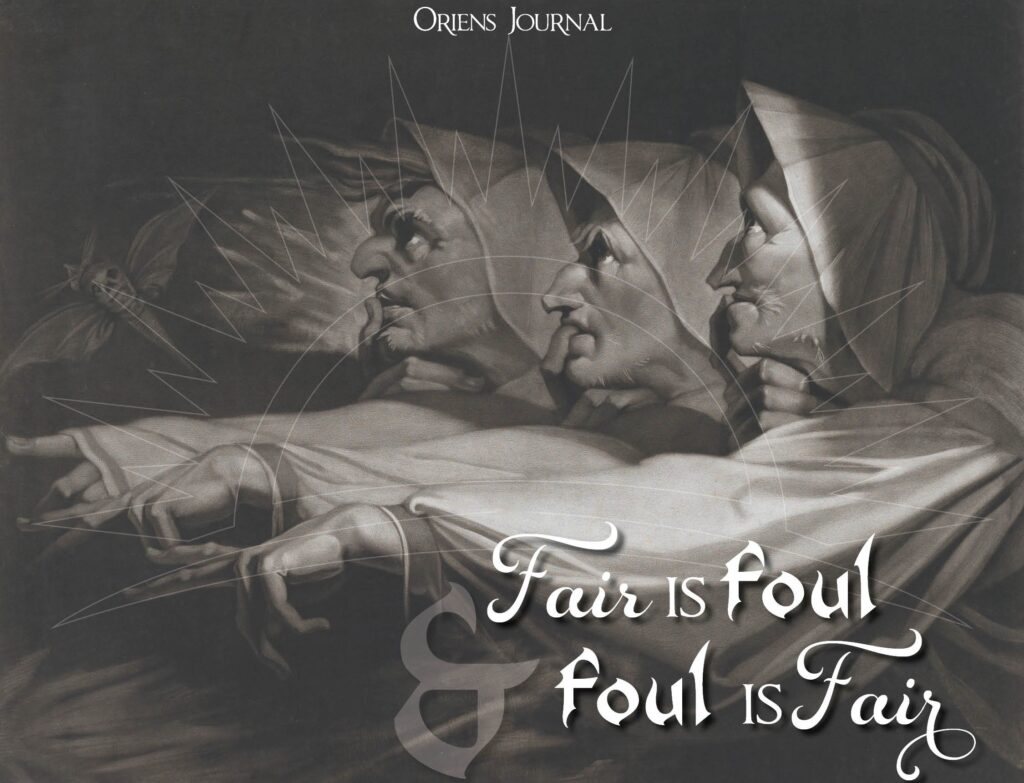First Witch:
When shall we three meet again
In thunder, lightning or in rain?
Second Witch: When the hurly-burly’s done,
When the battle’s lost and won. […]
Third Witch: Anon.
All: Fair is foul, and foul is fair:
Hover through the fog and filthy air (Macbeth, Act 1, Scene 1).
When all the emotions inevitably surrounding the death of a Pope have given way to calm, rational, faith-filled scrutiny, Jorge Bergoglio will undoubtedly be remembered by the Church in general as an instrument of Divine Grace. His life and teaching were exemplary in one respect: they were the complete, systematic consequence of the opening of the windows decreed by John XXIII to purportedly let some fresh air into the Church. While his three predecessors (Paul VI, John Paul II and Benedict XVI) retained a certain attachment to ancient mores and got used to the cold as best they could, Francis brought it all to its logical conclusion. The open windows were not enough; the walls, too, had to come down. John XXIII’s vision was that the Church needed to change, but in his mind, it somehow needed to change without changing; it needed to appear to the world as something different while remaining the same. The Francis pontificate has exposed beyond a shadow of a doubt the conciliar path for what it truly is: an exercise in duplicity, a forlorn wandering in the desert under the pretext of reaching out to others, a desperate attempt to appear relevant to the Church’s enemies while alienating her own children. From this tragic adventure, the Church must now return, under pain of dissolution.
Fair is Foul, and Foul is Fair
With these words of the three Weird Sisters in the opening scene of Macbeth, Shakespeare was unveiling for us one of the most fundamental dogmas of modernity, which was already deep at work in his day. Beginning even before the Renaissance but receiving a mighty impetus with Martin Luther, René Descartes, and Jean-Jacques Rousseau, the movement reached its climax with the Modernist crisis (which few speak of anymore because we are all infected by it). After a brief interval due to the energetic intervention of a very great Catholic Pope, St Pius X, who nearly squashed the deadly life out of it, the movement made a comeback. It succeeded in infecting almost the entire Church and, with it, civilisation in general. What shall we say is the starting point and the fundamental tenet of this movement, which sought to contradict what the Church was in all her glory in the High Middle Ages? It is none other than the initial cry of revolt of the first of the fallen angels: Non serviam – I will not serve! (Cf. Jer 2:20).

Christ Our Lord had come not to be served but to serve and give His life as a ransom for many (cf. Mt 20:28). He taught His apostles to teach the entire world that the only reason it exists is for human beings to attain glory in God’s kingdom through the practice of humility, obedience and service in this life. ‘Teach them to observe all things I have commanded you’ (Mt 28:20). There have always been those who took that message seriously and sought to live like Christ, knowing that what hangs in the balance is their immortal soul, which they rightly did not want to lose. In the Christian Catholic world, anyone who did not do so knew exactly what to expect after death: the exterior darkness where there will be the weeping and gnashing of teeth (cf. Mt 8:12, 13:42, 13:50, 22:13, 24:51, 25:30, Lk 13:28). Roughly from the Renaissance on, however, a movement began to throw off the yoke of the Gospel, so that people could ‘enjoy life’ (as if there could be any greater joy than living in God’s grace and progressing towards the beatific vision). The initial efforts in this direction did not sound all that revolutionary, but they did tend to organise life ut si Deus non daretur – as if God did not exist. According to the new mentality, there was nothing wrong with serving God and taking Him seriously, but this was by no means necessary. ‘God, you see, wants us to be happy, and being happy means embracing all things human and fleshly. If God did not want us to indulge in these things, He would not have made them’. So sang the sirens of the Renaissance that led so many to moral shipwreck.
But there was the problem of the Decalogue, the Ten Commandments. How to get around them? That was not really a problem for minds already infected with nominalism and distancing themselves more and more from realism. Things have names, they thought, but those names don’t really mean anything. ‘All that matters is me right here and right now with this thing I want to indulge myself in – this is life: to be lived to the full!’ In this way, it was easy to justify just about any sin and call it another name, and so we gradually came not only to accept, in theory, but to live in practice, that fair is foul and foul is fair. For once you start pushing back the line of demarcation between virtue and vice, the distinction becomes blurred. How else would it be possible to explain the widespread acceptance of unnatural practices such as contraception (restyled ‘safe sex’), abortion (restyled ‘interruption of pregnancy’) and sodomy (restyled ‘gay lifestyle’), which were all universally reproved (even when sometimes practiced) by our Christian ancestors, nay, by all God-fearing peoples?

The Pyjama Pope
What does this have to do with Modernism and the Bergoglio Papacy? Very much indeed. Recall his interventions in the moral field. Remember and never forget: Communion without repentance for the divorced and remarried; blessings of sodomitic unions; insults to women telling them they need not multiply like rabbits; appointing of pro-LGBT Cardinals who have the nerve to declare openly that the teaching of the Church on homosexuality is wrong and needs’ revision’; revamping of the Pontifical Academy for Life to fill it with members who are pro-contraception and even pro-abortion, etc. – the list is much longer but far too nauseating to continue. Where did these monstrous directives come from if not from a muddled mind that – perhaps even without realising it – wanted to have it both ways? Fair is foul, and foul is fair. Pay lip service to the commandments, come (and especially donate to) the Church, but rest assured that you may have the license to live as you please without being judged (‘Who am I to judge?’) and especially without being admonished (that would not be nice).
The Vatican II experiment was the fruit of a certain lassitude among men of the Church. Too many of them grew tired of reminding people of their duties, and they sought another way, a new way. ‘Maybe, just maybe’, they thought, ‘if we try embracing the world and telling the world in season and out of season, how wonderful it is, that we are friends of humanity, that we are all here to get along, maybe, just maybe, they will see how nice we are, and they will, by osmosis, start to live a Christian life. We must surely have just been too mean in the past – if only we had been nicer!’
And so the experiment began. Priests started to dress like the laity and hang out with them, nuns kicked the habit and began to spend their prayer time in front of the mirror instead of the tabernacle, bishops smiled whenever a complaint was made and then filed it away in a locked cabinet, and the Revolution went marching on. John Paul II and Benedict XVI were both keenly conscious of this grave state of affairs and they both, to their credit, attempted to rectify a number of excesses during the 35 years of their combined pontificates. To many, it seemed we were going in the right direction. It does not appear, however, that they ever came to the conclusion that the premisses of the conciliar adventure were patently false, that the Church could not embrace the world without being enticed by its sin. She had been formally warned and instructed not to love the world but to convert it. ‘Love not the world, nor the things which are in the world. If any man love the world, the love of the Father is not in him’ (1 Jn 2:15).
Within the ranks of the Modernists, however, those 35 years were a torment. Every opportunity was good to rail against the most recent decision of the Pope, with a ‘That’s pre-Vatican! Oh, the horror! You are resisting the Spirit! You can’t go back in time!…’ It was only to be expected (though most of us were taken by surprise) that the Revolution would succeed in electing its own Pope, who would retain nothing of his two reformist predecessors. This new Pope would not even try to be like them, whence his decision to live anywhere but in the papal apartments and to never appear wearing the traditional papal accoutrements except the white soutane – but even this, he succeeded in doing away with in the end, being seen in St Peter’s Basilica, of all sacred places, in his pyjamas! He would make every effort until the end to show that he intended to push the Vatican II agenda to its extreme so there could be no going back.
The most significant proof of this is that while he constantly preached about reaching out to the peripheries and being inclusive of all, he consistently and ruthlessly excluded one of the most significant and most oppressed minorities in the Church, namely those attached to the Traditional Latin Mass, going so far as to exclude them from parish churches. He had an ‘instinctive horror for all things Catholic’, are the words used by one horror-stricken Protestant commentator, and became notorious for calling traditional Catholics any number of names, such as ‘backwardists’, ‘reactionaries’, ‘little monsters’…
Fair is foul, and foul is fair. By papal fiat, the fair, that is, the Tradition of the Church, was now to be considered foul. By the same papal fiat, the foul, that is to say, sodomy, infidelity, promotion of vicious prelates, etc… all this was now fair. But it didn’t matter, because the Pope said so and this Pope was the saintly pope of the poor!
Iniquity Doth Lie to Itself
Under Bergoglio, moral theology became impossible. Hear the master himself: ‘Conscience can do more than recognise that a given situation does not correspond objectively to the overall demands of the Gospel. It can also recognise with sincerity and honesty what for now is the most generous response which can be given to God, and come to see with a certain moral security that it is what God himself is asking amid the concrete complexity of one’s limits, while yet not fully the objective ideal[1]’. Whereas up to then, according to the unanimous teaching of the Doctors of the Church and all serious moral theologians, it is God’s Law, the expression of God’s Eternal Essence, that dictates the parameters within which the human conscience can legitimately act, it is now the conscience that tells the God just exactly how far it feels it can go in conforming itself with the His Law. In other words, it is no longer about forming one’s conscience on God’s Law, acknowledging that one is not living in obedience to it, and doing violence to oneself in order to submit to His eternal decrees. Now (since the windows were opened 50 years ago…), God Himself caters to the whims of His creature and accepts that, in some instances, His demands are just too high. Apparently, it took God a few millennia to see that His demands were just a bit too exorbitant. God used to be mean, but now He is nice, just like the new Church! (Well, except to those who remain firm in the old ways….).
Needless to say, there is nothing that could not be justified in the eyes of the new Bergoglian moral theology. Every abortionist, every hitman, every onanist, every rapist, every sodomite, every pedophile, every adulterer, every usurer, every thief, every liar on the planet can always argue that in this particular situation the best response he can give to God’s law is to do exactly what he feels like doing, while distractedly hoping to be a good person, thinking all the while: ‘God has given me a conscience, and Pope Francis says that my conscience can determine just how far I’m willing to go in keeping God’s commandments, so God must be happy with me. I am really a good person, you know, and one day, when I’m very old, I will achieve the ideal’. Of course, no one ever went so far as to spell it out this way. Still, it is the unavoidable conclusion of the text, and indeed the only way to explain such enormous absurdities as the blessing of sodomy that Bergoglio himself seems to have wanted as the crowning plastic jewel in his pontificate, which opened the floodgates to vice in the Church.
Under John Paul II, especially in the jubilee year 2000, it became very fashionable to make public acts of repentance for supposed sins of the Church in former times (while carefully avoiding the sins of our day). Under Francis, at the last synod, a new act of repentance was devised, which included a new list of capital sins. Worthy of particular mention is the sin of ‘using doctrine as stones to throw’, which essentially accuses 2,000 years of true shepherds and theologians of throwing stones at people’s lives by preaching to them the demands of the faith and their moral duties as they were commanded to do by Christ Himself. All the while, the authors of this new morality fail to look themselves in the mirror, for if they did so, they would see that by accusing others of throwing stones, they themselves are engaged in the same activity: to stop people from throwing stones, they themselves are doing the throwing! So, it is that sin always contradicts itself. ‘Iniquity hath lied to itself’ (Psalm 26:12).
At the end of a failed and utterly disastrous pontificate, many of us may feel sad and dejected. The battle was lost under Francis. While we prayed that he would convert and recant before the end, we lost, and he won. But this battle, in reality, is only lost in appearance. With Francis, the Revolution in the Church was unmasked, and so he is the loser. It may not be long now before the revolutionaries still camouflaging themselves under the guise of Catholics – or, to use a Biblical expression, the ‘wolves in sheep’s clothing’ – will either follow him to the grave or be smart enough to sense that the wind is now blowing in another direction.

All clerics – future pope, cardinals, bishops and priests – you would be well advised to bear this in mind: the three generations of Catholics born since the windows of the Church were opened are sick and tired of the house being so damn cold. If you don’t start closing those windows yourself, others will do so, but not without having first thrown you out.
[1] Pope Francis, Apostolic Exhortation Amoris Laetitia, 19 March 2016, no. 303.


